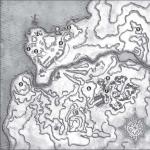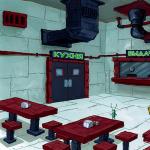Facing of the building in the German style. German style houses
If you are looking for a light and easy style to decorate, then this is German.
It is chosen by many people, as it differs from all others in that it is simple and practical.

In this article, you will learn how to decorate your home in the German style simply, but at the same time with designer taste.
Kitchen decoration
The kitchen room is the place where mostly women spend a lot of time. For the same reason, there should be everything that will make it more comfortable and cozy.

For the German style, cheap and not appropriate practical furniture and clutter, everything should be in its place. Furniture is best chosen from durable and natural materials that will have high functionality.

A special characteristic is light walls and floors, glossy coatings. As for the curtains, it is better to choose them not dark and those that will let in daylight. Tulle can be used if desired. On the ceiling, you can attach one not very large chandelier or several small LED lamps.

Strict and no less modern should look Appliances for kitchen.

If possible, build large appliances into kitchen cabinets. For decoration, choose fresh flowers, good option will be putting them in pots.
German style in the design of the living room
The living room is one of the most important rooms of the house, so it should be decorated carefully and, of course, tastefully.

Use only natural materials- a table with a glass top and wooden legs, as well as a wooden cabinet. Here the walls will also be light, but the floor should not be very dark, you can put a laminate on it.

The living room will be cozy and spacious if you decorate it with large quantity furniture. It can be just a sofa or a few chairs, not large sizes table and wardrobe.

You can decorate the room with different items. It can be, like family photos on the walls, and large vases on the floor. Small decorative pillows can be placed on the sofa.

As stated above, you do not need to hang heavy curtains that will not let in light. A simple and transparent tulle will suffice. To decorate the table, choose a light-colored tablecloth.

When decorating German-style apartments, it is worth saying that the living rooms there are often somewhere in the middle of the room itself.

For this reason, daylight may not be enough for full illumination. In this case, you can choose a sconce attached to the ceiling. Small spotlights will lose a bit of the German style vibe, so choosing them is not recommended.

Bedroom style
We also spend a lot of time in the bedroom - rest, enjoying sleep. As in other rooms, it is not appropriate here. extra furniture, which has no functionality.


Furniture, in the German style of the bedroom, should be chosen only from durable and natural materials.

In the bedroom, it is enough to have a spacious bed, a small chest of drawers for linen, cabinets near the bed. You can also place dressing table and a chair.

This room should be bright, so choose pastel shades of wallpaper, a white ceiling, delicate light furniture and a laminate floor, also light.

In the bedroom, add a picture on the wall, which will depict a landscape of nature. The window can be decorated with transparent tulle.

Attach either a chandelier or several spotlights to the ceiling. Near the bed, on the bedside tables, you can also place lamps. Place small soft rugs on the floor for comfort.


How to design a bathroom
When designing a bathroom, keep in mind that there should not be too many shelves and cabinets. Sanitary equipment choose simple, no extra decoration.

For the decoration of walls and floors, non-dark tiles are used. bathroom design German-style interiors should not be overloaded with color schemes, with a maximum of three colors.

If you have chosen the German style for decorating your home, you will definitely feel comfort, freedom and coziness.

Photo of the German style in the interior

















Many German cities have managed to retain their former charm. AT settlements, which escaped major destruction during the Second World War, urban development dates back many centuries, which is the subject of admiration for tourists. A half-timbered building to this day adorns the appearance of many old parts of cities.
We all know popular prints, already rather fed up, but, it seems, “not killed” clichés about Russia - balalaika, matryoshka and tame bear. But the standard idea of Germany is also not complete without the mention of Oktoberfest, sausages and, of course, such cozy, like gingerbread, German houses. This image of a homely idyll attracts many who are in love with Germany. But is it really so, and in what houses, like behind a stone wall, do German burghers live?
Fachwerkhaus ( frame house)
- this is just the same, "postcard" view of Germany: fairytale house, which you want to admire without ceasing - and it would be even better to live! The house consists of a wooden frame, the cavities of which are filled with a mixture of wood and clay or, in some cases, brick. Half-timbered houses are an integral part of the country's architecture; it is impossible to imagine Germany without them. As a rule, such houses are located in the old part of the city (Altstadt). 

 Reihenhaus (sectional house)- this is separate house, which is part of a line of houses built in a row. Sectional houses prevail in the development of the central part of cities. outside historical center cities are usually separate standing houses and houses for two apartments.
Reihenhaus (sectional house)- this is separate house, which is part of a line of houses built in a row. Sectional houses prevail in the development of the central part of cities. outside historical center cities are usually separate standing houses and houses for two apartments. 

 Doppelhaus it is usually a large semi-detached house. But you should not be afraid - you won’t have to share the premises with anyone except your family. In most cases, this type of housing is two houses with common wall, while each of which stands on its own land plot and has its own separate entrance. So there is no need to worry about how to get to the bathroom in the morning, ahead of the neighbors.
Doppelhaus it is usually a large semi-detached house. But you should not be afraid - you won’t have to share the premises with anyone except your family. In most cases, this type of housing is two houses with common wall, while each of which stands on its own land plot and has its own separate entrance. So there is no need to worry about how to get to the bathroom in the morning, ahead of the neighbors. 
 Einfamilienhaus (family house)- is a residential building that serves as a home for one family and contains one conditional apartment. As a rule, such single-family houses are owned by users and therefore they are also called private houses.
Einfamilienhaus (family house)- is a residential building that serves as a home for one family and contains one conditional apartment. As a rule, such single-family houses are owned by users and therefore they are also called private houses. 

 Sozialwohnung (council flat) This is a residential building built with the help of public public funds. These apartments are distinguished by a rather low rent, since they are intended mainly for low-income segments of the population (large families, people with disabilities).
Sozialwohnung (council flat) This is a residential building built with the help of public public funds. These apartments are distinguished by a rather low rent, since they are intended mainly for low-income segments of the population (large families, people with disabilities).  In order to rent such an apartment, you must have a special permit. This permission, respectively, is received by persons whose income does not exceed a certain allowable limit. Municipal apartments are received on a first-come, first-served basis, but since there are more people who have the right to rent such apartments than the housing itself, they are distributed in order of urgent need. For example, it is more likely that municipal housing will be issued to a pensioner with a disability who lives on the 5th floor in a building without an elevator.
In order to rent such an apartment, you must have a special permit. This permission, respectively, is received by persons whose income does not exceed a certain allowable limit. Municipal apartments are received on a first-come, first-served basis, but since there are more people who have the right to rent such apartments than the housing itself, they are distributed in order of urgent need. For example, it is more likely that municipal housing will be issued to a pensioner with a disability who lives on the 5th floor in a building without an elevator.  Wochenendhaus (summer house) is a house or hut located in a rural, natural area for spending holidays or weekends there. Some summer houses are in really beautiful places: by the lake or with mountain view. From small garden plot on the outskirts of the city (Schrebergarten, Kleingarten) summer houses differ, first of all, in size. They are usually provided with modern plumbing, gas and electricity.
Wochenendhaus (summer house) is a house or hut located in a rural, natural area for spending holidays or weekends there. Some summer houses are in really beautiful places: by the lake or with mountain view. From small garden plot on the outskirts of the city (Schrebergarten, Kleingarten) summer houses differ, first of all, in size. They are usually provided with modern plumbing, gas and electricity. 

 Bungalow- is a one-story house that can have various options roofs The word itself comes from North Indian languages and literally means "in the Bengali style." The history of the distribution of such a residential building is connected with the fact that in the 18th century the British colonialists who lived in the Bengal region took local houses as a model for building housing and reproduced them. Typical bungalows have one floor and a spacious veranda. In Germany, the peak of popularity of the bungalow came in the 60s of the 20th century.
Bungalow- is a one-story house that can have various options roofs The word itself comes from North Indian languages and literally means "in the Bengali style." The history of the distribution of such a residential building is connected with the fact that in the 18th century the British colonialists who lived in the Bengal region took local houses as a model for building housing and reproduced them. Typical bungalows have one floor and a spacious veranda. In Germany, the peak of popularity of the bungalow came in the 60s of the 20th century. 

 What house would you like to live in?
What house would you like to live in?
Has a long history. The style loved by Europeans was borrowed by domestic architects and designers. What is the secret of the popularity of German cladding, what are the basic principles of technology and how to imitate fachwerk on your own?
Features of German technology
Fachwerk decoration is a kind of grid of wooden beams applied to the facing of the house in a contrasting color. This solution has a number of advantages:
- Versatility. Stitching decorative beams suitable for small country houses and spacious cottages. Facade can be combined with others style directions characteristic of a certain area.
- Ease of arrangement. The technology is not difficult. The main thing is to plan the location of the beams in advance and prepare the material.
- Sophistication. A variety of wall textures and colors allows you to create exclusive facade. Design suggests unity with nature - outdoor wooden frame gives the house a special charm.

Of the minuses of the technology, one can note: the relative high cost of the materials used and the fragility of wooden elements.
The choice of material for the arrangement of the facade
The service life, ease of installation and practicality of the operation of the cladding largely depends on the right materials. Special attention it is necessary to give the base for the facade half-timbered and stuffed planks.
natural wood or imitation
The choice lies between wooden or polyurethane boards. Each material has pros and cons.
Distinctive features wood beams:
- naturalness and environmental friendliness;
- beautiful appearance;
- the need for careful preparation - treatment with flame retardants and protective impregnations;
- susceptibility to decay;
- high cost.

Good alternative to wood polyurethane beams. The main advantages of polymers:
- plausible imitation of the texture and shades of wood;
- wide selection colors false beams;
- light weight - polymer boards hollow inside, such a finish does not give a special load on the lightweight foundation of the frame;
- excellent technical and operational properties: resistance to UV rays, temperature extremes, resistance to decay, inertness to organic matter and the absence of deformations.
An important argument in favor of imitation of fachwerk with polyurethane beams is the affordable cost of polymer materials.
Fachwerk base options
Installation of beams takes place on a prepared base. Three options are popular in frame housing construction:
- DSP sheathing;
- wall plastering;
- use of OSB boards.

The most practical method is the use of cement-bonded particle boards (DSP). The material has a high density, tolerates longitudinal loads well and is not afraid of precipitation. DSP sheathing gives the frame additional strength.
Composite boards – best base under fachwerk. Value for money technical qualities material is optimal.
Plastering walls is a labor-intensive process. In addition, given the features of prefabricated houses, this method is not recommended for cladding. Temporary movements of the frame can lead to cracking of the plaster layer.
OSB boards- budget technology. The material is suitable for use in the construction country houses and small buildings.

The nuances of using OSB-plates:
- high-quality processing with bioprotection is necessary to prevent the appearance of mold;
- special attention to the ends of the paintings - with regular contact with water, they can swell;
- over time, OSB boards change color and require painting.
Step-by-step instructions for finishing the facade
Let's describe the order of finishing the facade of a half-timbered house with our own hands. The entire course of work can conditionally be divided into several stages.
Design and sketch development
First of all, you need to make layout plan of wooden beams. It is necessary to build on the working drawing of the house itself.

When drawing up a sketch, you should adhere to the following rules:
- the placement of the racks is not tied to the seams of the DSP boards; on the contrary, the cladding panels are “adjusted” to the sketch of the location of the beams;
- top and, crossbars, braces and vertical supports should leave the impression of not decorative, but load-bearing elements;
- in the layout of racks and boards, symmetry is welcome; in the frame of window and door areas, it is desirable to adhere to a single tactic.

Necessary materials and tools
To implement the half-timbered facade, you will need the following materials:
- DSP boards 12-16 mm thick;
- wooden beams 15 cm wide or polyurethane planks;
- bars for attaching the DSP to the frame;
- insulation;
- windproof membrane;
- fasteners - wood screws 3.5 * 5.5 mm;
- paint, protective.
From the tools you need to prepare: a puncher, a screwdriver with nozzles and drills, a grinder for cutting plates, a level, a tape measure, a spatula, a roller, a square and a pencil.
Cutting and fixing DSP boards
Comparing the dimensions and configuration of the walls with the dimensions facing plates, it is necessary to cut the DSP. Before installing the canvases, it is necessary to "fill" the frame heat-insulating material, and fix on top of the insulation windproof membrane.

Following actions:
- Fix vertically wooden blocks– the fastening step depends on the width of the cut DSP sheets.
- Drill holes in the plates: the diameter is equal to the thickness of the self-tapping screws, the step along the edges is 20 cm, in the middle - 40 cm, the indentation is from 1.5 cm.
- Treat the ends of the sheets with a strengthening primer.
- Fix the DSP slab, keeping a gap between the elements of 3-5 mm. The head of the self-tapping screw should go deep into the canvas by 1-2 mm.
Priming and painting walls
At this stage, the walls are finished before attaching the beams. Work progress:
- Fill the gaps between the DSP boards with a weatherproof compound. It is also necessary to process the attachment points - the caps of the self-tapping screws.
- Apply the strengthening primer to the walls using a roller. Leave the surface to dry completely.
- Prepare the paint, thoroughly mix the base with the color and apply to the walls.

As a rule, one layer is not enough to cover the gray DSP boards. To achieve uniformity of color, it is desirable to repeat the staining.
Preparation and installation of beams
Boards for finishing the facade should be well dried. Further, the material is sanded, treated with flame retardant impregnations and protective compounds.
Such measures are aimed at reducing the ability of wood to ignite and increase resistance to precipitation and solar radiation. Impregnation with an antiseptic protects the beams from the appearance of rot and insect invasions. The final stage training- painting the boards in a dark color.

- Cut lumber according to the sketch.
- Fix the finished elements with self-tapping screws, observing the layout plan.
The procedure for working with polyurethane strips is somewhat simpler. They do not require pre-treatment and are fixed to the DSP with liquid nails.
Fachwerk decor secrets
Facades of houses in the German Fachwerk style have some common features in execution:
- The floors are visually separated by one or two rows of horizontal beams.
- AT window frames bindings are present.
- Entrance doors - mostly massive wood, without glazing.
- Drainpipes, chimney and ventilation outlets match the color of the beams.
- The foundation of the house is decorated with natural or artificial stone.
- Fachwerk tradition is to decorate window sills with flowerpots and planters with flowers.

The beautification of the facade in the medieval European style has taken root in modern frame housing construction. Fachwerk imitation can radically change the appearance of the building, giving it originality and presentability.
Video: fachwerk on a house insulated with foam
An American, having moved to Germany, wrote an interesting post about the difference in housing arrangements between American and German houses- . Sometimes some things only amaze an American (such as a hanging toilet), but sometimes they surprise me too (roller shutters down throughout the house, regardless of the time of year or day).
German houses are not usually built with brick or wood, but with metal rebar and sand/limestone mix. Outside and inside the walls are covered with plaster and paint (outside - usually yellow, inside - white). Wallpaper is not used due to high humidity. American houses, usually built of wood/plywood, do not require a signal amplifier to wireless wifi. In a German home, it is required.
In Germany, they prefer to rent a house, rather than having their own. For example, in Berlin, more than 80% of people live in rented housing. Perhaps this is due to a lack of funds (the salary is small and you don’t want to be bound by a loan), or perhaps people do not see their future in this city and want to have freedom of choice and movement. If in America it is common to rent housing for a period of 1 year, then in Germany the minimum period is usually 3 years. The more, the more convenient for the landlord.
AT german houses usually there is no central air conditioning and heating system (grilles in the ceiling and on the floor). With the American hot climate and high humidity You just need constant air conditioning. But Germany is located to the north, it is enough to ventilate the rooms here. Although in old German houses, which are already several centuries old, there is often stubborn mold. The Germans may use small household fans. In cold weather, houses are heated hot water, which is fed into batteries on the wall or under the floor ("warm floors"). The heating level can be adjusted independently. No wonder Germans use less electricity than Americans.
Heating under the window. Balcony door made entirely of glass
But there are light motion sensors that save electricity. For example, they work near the entrance, in the corridor, in the basement.
It was a revelation to Americans that windows could be opened vertically. Sometimes they write on forums that they broke a window in a rented apartment and ask how to fix it and what to say to the landlord. Also, the Americans are puzzled why the Germans do not insert insect screens into all windows. It's just that in Germany all sorts of chemicals are sprayed from helicopters in swampy areas so that mosquitoes do not breed. There really are almost none. Summer night turns into torture for Americans, as all the moths and bugs fly from the darkness to the bright house. The battle between fresh air and lack of insects. Once an American woke up from the fact that a grasshopper was sitting on his chest.
AT german houses usually in each room there are built-in roller shutters (metal, wooden, plastic). They will be everywhere, except for the windows of the bathroom and toilet. Among Americans, such strong window fortifications are found on the East Coast or in the southern states, where hurricanes are frequent and windows need to be saved from strong wind and flying debris. Or with the help of thick blinds in the south they escape from the sizzling sun. Americans are wondering why such powerful blinds are needed where there are no hurricanes and the hot south? Versions under consideration:
So that at night the light from street lamps does not interfere with sleep (but the blinds are lowered at night in all rooms);
- so that in winter, leaving the house, to keep it warm (but modern double windows and thermal insulation of the walls perfectly retain heat);
- in order to keep the house cool in the summer (the Germans are afraid of drafts, so they do not ventilate the house in this way in the summer);
- so that the glare of light does not fall on the TV screen;
- to keep their private life secret (it seems to them that 60% of the time the neighbors look out of their windows);
- to feel safe (it seems to the Americans that the Germans thus prepared for the zombie apocalypse);
- perhaps this is a memory of the time when in July 1939 an instruction was issued on the need to tightly close the windows with blankets at night so that the light from inside the house was not visible.
- perhaps there is no logic here. Enough habit that my mother and grandmother did this.
For example, in Holland they rarely curtain their windows, rather they try to decorate them with orchids, lighthouses, seagulls ... The Dutch like to live without curtains, as if demonstrating to all people that they have nothing to hide. Perhaps the Dutch like to look out the window more often than the TV. Perhaps this is their favorite TV program. Or maybe the Dutch just love the sun and don't like to turn their houses into underground spaces where no light can penetrate.
Dutch house in the evening.

Window shutters are what most surprise Americans in Germany. But those shutters on century-old buildings never close.

Usually residential buildings in German towns look like this day and night:

Maybe this is an echo of the war and it seems to them that a sniper is sitting on the roof? But the whole of Europe was at war.

When you move into a rented apartment, you need to be prepared for the fact that instead of lighting in the rooms there will be only wires. buy light bulbs lighting and you have to install them yourself. For example, at first we were very helped out by two desk lamp brought with you..
Americans are surprised that German toilets have not one but two flush buttons and they are different! In the US, older toilets use 13.6 liters of water to flush, newer ultra-low-flow toilets use 6 liters. In Germany, pressing a large button uses 7.5 liters of water, and a small one - 3.8 liters.
Also for Americans, the design is amazing wall hung toilet. They are used to having it attached to the floor. And it’s also surprising to Americans that there is a brush in the toilet ...
Americans are used to the fact that in the kitchen waiting for them is a two-door refrigerator with a minimum height of 1.8 m, a huge oven and a large space for utensils and creativity. German cuisine disappoints them in this regard. Not all rented German houses have kitchen furniture, and if there is, then it is not at all "American" in size. When baking a turkey in a German oven, the Americans even have to cut off its legs, otherwise it simply does not fit inside.
Usually, at the entrance to a rented apartment, new tenants in the kitchen expect only the possibility of connecting water and electric wires. The previous tenants will even take the sink and countertop with them (most likely, because of its size, it will be useless in a new place, but here the Germans are driven not by logic, but by a sense of justice - you didn’t pay them for this kitchen). Usually kitchen furniture tenants buy on their own or buy cheaply from previous tenants who moved out (fortunately, people rarely move in Germany).
What does a typical American stove look like:

What does the kitchen look like in a rented German apartment (a small elevation on the left is a refrigerator):

Now I'm starting to understand why the Germans go to the store every day ... They simply do not fit anything at home. However, from the previous post, you already understood that the Germans prefer not to cook at home, they eat ready-made food that needs to be warmed up as much as possible (What do they eat in Germany? and).
German built-in oven:

What did the Americans do first? Of course we bought new refrigerator! True, they did not measure in advance the doorway of the closet where they intended to put him, but he climbed in anyway:

The storage room inside the apartment is often used to install an additional refrigerator or freezer. At our house, for example, there is a place for connecting washing machine. Also, usually the apartment is supposed to have a basement where you can store bicycles, skis, rods and whatever your heart desires (except for combustible and flammable items). Yes, when moving, the Germans will also take the dryer and washing machine with them.
If in America a large and beautiful space is accepted in front of the house, then the Germans have the opposite: in front of the house there will be quite small space, and all the beauty will be behind the house, away from prying eyes. Even apartment buildings in Germany, unsightly from the street, will have a pretty patio. Perhaps this is because the Germans do not want to "show off" their beautiful yards, while the Americans, on the contrary, like to look attractive. Usually in the backyards, the Germans cook sausages and fry meat.
In American homes, it is customary to make wall niches that can be closed, which can be conveniently used as dressing rooms or pantries. They will be present even in the smallest apartments in New York:

In Germany, instead of such niches, they buy furniture where they hang and fold clothes. Americans believe that cabinets are what Ikea does its main business in Germany.
Americans are used to their big houses have large furniture. But it just won't fit in the comparatively smaller German apartments. For example, this big dinner table for 10 people and chairs, the Americans had to sell before moving to Germany:

Of course, there were still difficulties in finding an adapter for equipment designed for a different mains voltage. For example, electronics bought in Germany will not work in the US unless adapters or transformers are used. Therefore, those who leave Europe for America usually sell all their equipment through websites at low prices. This is very convenient for those who move to Germany and do not want to invest a fortune in the purchase of new equipment. The EU electrical plug is different from the US one (2 small round pins vs 2 small flat prongs). Things that usually don't work from the US: TVs, irons, hair dryers, coffee pots, electric shavers, lamps, etc.
I'll add on my own:
If the house is old, post-war construction, most likely the bathroom will only have a shower. But at modern renovation everything looks nice:

In old houses, the division of rooms into a kitchen and a dining room has been preserved, i.e. they don’t eat in the kitchen, they only cook (however, as in the pre-revolutionary houses of Moscow and St. Petersburg).
Small German kitchen. Cooking here:

Here they eat:

In the kitchen, you can only have a bite to eat, sitting at this impromptu table on high bar stools:

The central place in the living room is occupied by a TV (each room of the German house has a TV outlet). For example, our neighbors watch TV as if on schedule - every day from 18:00 to 22:00. Then they lower their blinds and you can't hear them. His barbell continues to lie in the shed, her bike is there. It seems that in their life there is only home and work.

The German bedroom differs from others in that an additional switch will be arranged above the bed. Americans are surprised that in Germany there are big switches, not in the form of a lever. Very often, even on a double bed there will be two separate blankets (and not one large one) and there will be no bedspread on top (this is a wonder for the Germans). Terry stretch sheets are often used.

For some reason, the Germans avoid eating on the balconies, although they buy flowers, trees and beautiful furniture there.
The balcony in Holland is literally created for lunches and dinners:

Nice balconies in Heidelberg.

What are German houses -
Today, many are tired of the noise of city life and seek to buy or build housing outside the city. If you have purchased suburban area and planning to start construction there, pay attention to the house in the German style.
German style house facade
The house, built in the German style, is distinguished by the rigor and simplicity of details, rationality and practicality. appearance building. On the facades of houses in the German style there are no pretentious elements and other sculptural decorations.
Today one of the popular German architectural styles is, which is characterized by vertical frame structures, diagonal braces and horizontal beams. Moreover, beam structures are most often made in contrasting shades compared to the main background of the building. On the facades of German-style houses, half-timbered elements are perfectly combined with natural or artificial stone trim.
The German style may also contain . Such houses with pointed roofs and vertical elongated windows look catchy and outstanding. Cottage with a German-style veranda often has columns that have not only a decorative function, but also serve as a reliable support for the roof of the veranda.
The German-style house with protruding bay windows looks great. At their expense, the house increases living space, and bay windows glazed around the entire perimeter of the building serve as a wonderful decoration for the house.
 |
 |
|
 |
 |
|
 |
 |
 |
Interior decoration of the house in the German style
The interior design of the rooms of the house in the German style is practical and reliable. The rooms are light, as the German style suggests the presence large windows and even glazed roofs.
The German interior is dominated by muted calm and warm colors. The combination of a dark floor and light walls is considered traditional.
Furniture for a German-style room is distinguished by practicality, neatness and high quality manufacturing. Only natural and simple materials are used for its production.
 |






